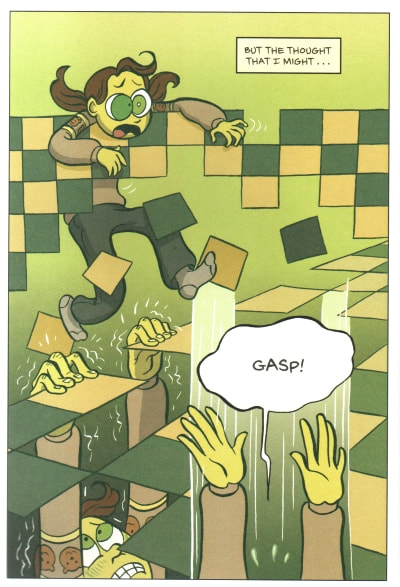|
Guts. By Raina Telegemeier. Scholastic/Graphix. ISBN 978-0545852500 (softcover), $12.99. 224 pages. Raina Telgemeier is an engine, a star, a phenomenon. All of us who follow the world of graphic novels have heard this. For several years Telgemeier has borne a job description that, until recently, perhaps no one imagined we would ever need: America’s best-selling graphic novelist. Hype surrounds her like a halo (go, Raina!) Her success is proof of the graphic novel’s decisive new mainstreaming, and further proof, if any were needed, of the buying power and cultural clout of tweenage girls. She is, we’re told, “the Judy Blume of graphic novelists,” and her stardom has been a bellwether of the children’s graphic novel movement. Telgemeier’s publisher, Scholastic, has capitalized on all this with gusto, rolling out the red carpet for each new release and boosting Raina to million-copy print runs. Earlier this year, a spinoff product, Share Your Smile, a kind of “interactive journal,” signaled a new phase in the branding of Raina: an exhortation to her readers to write their own autobiographical stories in the vein of Telgemeier’s breakout books, Smile and Sisters. I honestly don’t know what to think of Share Your Smile, which seems more about design than revealing content: a guided activity book comparable to Wreck This Journal, The Diary of an Awesome Kid, and so many others. I suppose I had wanted to see something more reflective or essayistic, less about prompts and nearly-blank pages for readers to fill in. (It strikes me that young readers may get more from how-to cartooning books like James Sturm et al.’s Adventures in Cartooning or Ivan Brunetti’s Comics: Easy as ABC!) Telgemeier’s latest, though, Guts, now that’s a real book — and for me, her best. Guts is a middle-grade girlhood memoir akin to Smile and Sisters, and designed to match (Telgemeier’s autobiographical books and fictional books are distinguished by different design schemes). It’s in familiar Raina territory: a story of social awkwardness and anxiety, family and friendship, and the minute moral decisions and moments of confusion, defensiveness, and selfishness that can make school life so complicated. Predating the events of Smile, it depicts Raina, the author’s childhood self, going through fourth and fifth grade. Though it matches its sibling titles (indeed, Scholastic has just released all three in a boxed set), it stakes out its own thematic turf, revealing Raina’s anxieties and phobias in an emotionally charged way that goes a step further. It’s a brave book, and, I’m tempted to say, one that only a well-established children’s author could get away with. Guts depicts panic attacks and (as the title hints) upset stomach, cramping, and retching, as well as social and eating-related anxieties. It joins the considerable body of autobiographical comics that deal with anxiety, psychological distress, and neurodivergence. (Such themes are foundational to autographics as a genre, from Justin Green onward.) For a middle-grade graphic novel, Guts is, well, gutsy; it includes many scenes visualizing physical and psychological discomfort, and in some cases sharp pain and outright terror. It also includes quite a few scenes of bathrooming, bodily embarrassment, doctor’s office visits, and therapy sessions. “Treatment” is essential to its story. In short, Guts contributes to the graphic medicine movement. In the process, it yields the most harrowing and inventive pages Telgemeier has yet created. At the same time, Guts is very much a young reader’s book, never forgetting its main audience and taking care to explain and palliate the scary stuff—not with promises of quick cures and happy-ever-afters, but by showing that anxiety and panic are survivable and can be understood and, with practice, coped with and reduced. Young readers who dig Telgemeier’s books are likely to find Guts a warm, awkwardly funny, and ultimately reassuring guide. I tend to think that Telgemeier’s best books are her memoirs. Her fictional graphic novels to date, Drama and Ghosts, have been well-intentioned liberal fables with under-examined premises (Drama has been faulted for reproducing romantic stereotypes of the antebellum South, and Ghosts for naive cultural appropriation and whitewashing colonial history). Both have tried to do good things: Drama is a queer-positive, gender-defying romance, and Ghosts a story of family affected by illness and disability. But they aren’t tough-minded books, and Telgemeier doesn’t quite skirt the pitfalls built into their premises. In her memoirs, however, Telgemeier has crafted a believably human alter ego, just anxious and at times selfish enough to pose serious ethical dilemmas, and she has a way of disclosing certain hard things that don’t get solved, even as her boisterous cartooning conveys a bright, affirming outlook on life. The balance is exquisite, and Telgemeier usually nails it. Guts is the Raina book I’ve liked best. I will remember its formal gambits (startling for a middle-grade graphic novel) and its honesty. Telgemeier, at once a first-class storyteller and a commercial powerhouse, has clearly hit her stride. This book take chances, the chances pay off, and I’m impressed by the way she manages to walk the tightrope.
0 Comments
|
Archives
June 2024
|





 RSS Feed
RSS Feed
